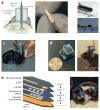Optical neural interfaces
- PMID: 25014785
- PMCID: PMC4163158
- DOI: 10.1146/annurev-bioeng-071813-104733
Optical neural interfaces
Abstract
Genetically encoded optical actuators and indicators have changed the landscape of neuroscience, enabling targetable control and readout of specific components of intact neural circuits in behaving animals. Here, we review the development of optical neural interfaces, focusing on hardware designed for optical control of neural activity, integrated optical control and electrical readout, and optical readout of population and single-cell neural activity in freely moving mammals.
Keywords: GCaMP; channelrhodopsin; halorhodopsin; imaging; neurophysiology; optogenetics.
Figures




References
-
- Penfield W, Perot P. The brain’s record of auditory and visual experience: a final summary and discussion. Brain. 1963;86(4):595–696. - PubMed
-
- Salzman CD, Britten KH, Newsome WT. Cortical microstimulation influences perceptual judgements of motion direction. Nature. 1990;346(6280):174–77. - PubMed
-
- Mayberg HS, Lozano AM, Voon V, McNeely HE, Seminowicz D, et al. Deep brain stimulation for treatment-resistant depression. Neuron. 2005;45(5):651–60. - PubMed
-
- Yizhar O, Fenno LE, Davidson TJ, Mogri M, Deisseroth K. Optogenetics in neural systems. Neuron. 2011;71(1):9–34. - PubMed
Publication types
MeSH terms
Substances
Grants and funding
LinkOut - more resources
Full Text Sources
Other Literature Sources

